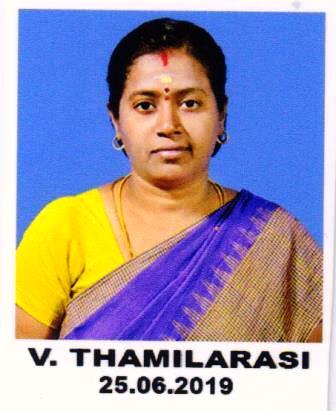V. Thamilarasi
@srisaradacollege.ac.in
ASSISTANT PROFESSOR IN COMPUTER SCIENCE
SRI SARADA COLLEGE FOR WOMEN(AUTONOMOUS)
ASSISTANT PROFESSOR IN SRI SARADA COLLEGE FOR WOMEN(AUTONOMOUS)
EDUCATION
M.Sc, M.Phil, MCA., Ph.D IN COMPUTER SCIENCE
RESEARCH INTERESTS
MEDICAL IMAGE PROCESSING, DATA MINING
FUTURE PROJECTS
Efficient Classification by RESNET-50 and compare by deep learning architectures for lung chest X-ray images
I have already completed this work and i need collaboration for SCI publishing only
Applications Invited
Interested persons communicate me
6
Scopus Publications
Scopus Publications
- Intelligent decision model based on deep reinforcement learning for soccer games outcome prediction using optimal feature extraction and optimization
V. Thamilarasi, R. Roselin, Kirti H. Wanjale, and P. Pushpa
IGI Global
In this study, the authors propose an intelligent decision model, the deep reinforcement learning for soccer games outcome prediction (DRL-SGO), using optimal feature extraction and optimization. Initially, they design a feature extraction model based on DenseNet to extract soccer games domain knowledge, including recency and rating features, from the given dataset. Subsequently, they use the artificial rabbit optimization (ARO) algorithm to optimize features, selecting the best among a multitude of options. Additionally, they employ deep reinforcement learning (DRL) techniques to enhance the accuracy of predicting soccer game outcomes. Finally, they validate the performance of the proposed DRL-SGO model using the 2017 soccer prediction challenge dataset. Remarkably, the DRL-SGO model achieved an accuracy of 93.991%, precision of 89.169%, recall of 90.537%, and F-measure of 89.843%, showcasing its impressive predictive in the realm of soccer game outcome forecasting. - AI-Powered Real-Time Runway Safety: UAV-Based Video Analysis with ICSO-Enhanced Deep Learning
V. Thamilarasi, R. Hema, A. Noble Mary Juliet, Adlin Sheeba, Gauri Ghule, and A. Raja
Iskender AKKURT
In the aviation sector, ensuring safe landings while prioritizing the safety of runways is crucial to prevent accidents and incidents during the landing phase of flights. However, many studies analyzing unsafe events, such as runway cracks or inadequate friction, often fail to quantify their impacts on flight safety during landing. In airport pavement management systems (APMS), the condition of the runway surface is a critical factor in ensuring the operational safety of aircraft during take-off and landing. Therefore, it is essential to provide pilots with reports on runway conditions, including measurements of surface performance, to support informed decision-making. To tackle these challenges, we propose a real-time automatic monitoring system for runway safety utilizing video analysis. Specifically, we employ a time-series analysis approach using the improved chameleon swarm optimization (ICSO) algorithm to mine runway surface characteristics from real-time video data captured by unmanned aerial vehicles (UAVs). Subsequently, we introduce the fuzzy reinforced polynomial neural network (FR-PNN) to detect risks in runway surface characteristics, enabling automatic monitoring to enhance the safety of aircraft landings. Finally, the effectiveness of the proposed system is validated using real-time videos obtained from Bechyne military airport, located in Bohemia. This system aims to improve runway safety by providing timely and accurate assessments of runway conditions, thereby facilitating safer landings for aircraft. - Quantum Computing - Navigating the Frontier with Shor's Algorithm and Quantum Cryptography
V. Thamilarasi, Pramod Kumar Naik, Isha Sharma, V. Porkodi, M. Sivaram, and M. Lawanyashri
IEEE
This abstract discusses the transformational capacity of Shor’s Algorithm and quantum cryptography in quantum computing. However, Shor’s Algorithm poses a problem to classical cryptographic systems such as RSA encryption because of its apparent capacity to multiply speed the integer factorization. This approach relies on multimillions qubit quantum computers with systematic error correction which have yet to be implemented. Quantum cryptography revolutionizes secure communication via Quantum Key Distribution (QKD). It uses quantum mechanics to design the unbreakable key exchange system that can identify eavesdropping. Despite the prospect, quantum cryptography is hampered by limits in distances and speeds of QKD transmission. Quantum repeaters and satellite-based QKD make it possible to overcome these difficulties and facilitate the creation of a secure global communication grid. The comparison of classical and quantum cryptography illustrates an evolution from complexity-based security to quantum physics security, which is immune to quantum computational attacks. Reports of quantum supremacy and QKD network development are stages on the way towards quantum computers and cryptography. Technology challenges on this approach include scalability of quantum systems, qubit coherence, and error correction. Quantum computing has the potential to transform computer and communication security. This route involves innovation in quantum technology development, as well as integration issues. Quantum computing and cryptography’s full potential would lead to an age of new computational possibilities that will change the encryption of data and secure communication. - Application of machine learning in chest X-ray images
- Classification of Lung Chest X-Ray Images Using Deep Learning with Efficient Optimizers
A. Asaithambi and V. Thamilarasi
IEEE
This paper investigates the application of several deep learning architectures such as VGG-16, VGG-19, ResNet-50, and Xception Net for lung chest X-ray images, with 5, 10, and 15 epochs, and different optimizers such as Adam, SGD, and RMSProp, and a learning rate of 0.0001. The investigation finds that when adaptive gradient is used, the VCG-16 architecture achieves 68% accuracy; VCG-19 achieves 67% accuracy; ResNet-50 achieves 98.67% accuracy; and the Xception Net architecture achieves less than 50% accuracy. With further experimentation using 5, 10, and 15 epochs and optimizers such as Adam, SGD, and RMSProp, a 100% accuracy was achieved with 15 epochs for the VGG-16, VGG-19, and ResNet-50 architectures. However, Xception Net has been able to achieve only 70% accuracy with these optimizers. - Automatic thresholding for segmentation in chest X-ray images based on green channel using mean and standard deviation

